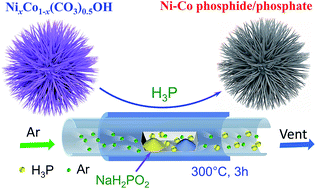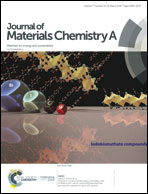Sea-urchin-like nickel–cobalt phosphide/phosphate composites as advanced battery materials for hybrid supercapacitors†
Abstract
In this study, sea-urchin-like bimetal nickel–cobalt phosphide/phosphate (Ni–Co–P/POx) samples were first synthesized by a low-temperature phosphating method. The phosphide phase shows a crystal nanoparticle morphology distributed in the matrix of the amorphous phosphate phase. By theoretical calculations, it has been found that NiCoP shows a metallic conductivity property because the density of states crosses the Fermi level, and it exhibits better electrochemical activity than Ni2P and CoP owing to the presence of more electrons close to the Fermi level; moreover, the effects of phosphorization and bimetallic properties on the charge storage performance of Ni–Co–P/POx have been investigated, and the results indicate improved electrochemical activity, rate capability and cycling stability. Ni–Co–P/POx with the Ni to Co molar ratio of 1 : 1 shows the best performance, and it exhibits electrochemical activity greater than and rate performance comparable to that of the oxide. Ni–Co–P/POx with the Ni to Co molar ratio of 1 : 1 shows a specific capacity of 647 C g−1 at 1 A g−1 and specific capacity retentions of 67% and 94% after the specific current increases by 50 times and after 1000 cycles, respectively; this indicates that high electrochemical activity, rate performance and cycling stability performances have been simultaneously achieved. In addition, a Ni–Co–P/POx//reduced graphene oxide hybrid supercapacitor was assembled, which showed good electrocapacitive performance.



 Please wait while we load your content...
Please wait while we load your content...